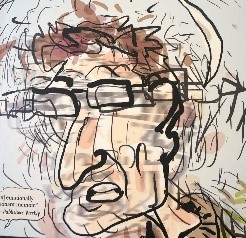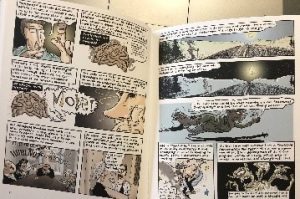This drawing here has very few defined outlines, is a blur to look at, and almost seems “pieced” together. As a reader, it’s hard to comprehend what he truly looks like. This ties into one of our earliest class discussions on the patient-doctor relationship. We explored the postmodern issue of patients who lack a role in their own treatment methods. Patients themselves barely exist in any clinical assessment because modern medicine only focuses on disease mechanisms. A few ways that we’ve learned how patients can exist in medicine is through storytelling and understanding their different cultural perspectives. Thus, doctors actually need a definite body, a true image, one capable of speech to clearly communicate to the observer or they will risk walking away with only pieces of their entire tale.
Another image packed with connections to our discussions on the patient-doctor experience is of Dunlap-Shohl describing the “language of Parkinson’s.” First, this image is displayed in many boxes and could possibly cause confusion as the reader looks at one place immediately to the next. This arrangement reflects the difficulty to grasp all that Parkinson’s disease encompasses. Even the wide vocabulary of words is difficult to understand because they seem to have multiple pronunciations and many different ways to look at them. What’s even more frightening is that these are the odd conversations that circulate in the world of medicine in which doctors like to bombard patients with all the nitty-gritty medical terminologies.
A final image is one that personifies Parkinson’s disease—a green monster. There’s only one bright side to looking at this monster, and that’s that it gives the disease a meaning. Thus, Dunlap-Shohl is helping the reader identify with this disease in a way that restores understanding so that we can respond appropriately to his incredible memoir.
Paragraph 1. Image to the left
 Paragraph 2. Image to the right.
Paragraph 2. Image to the right.
Works Cited
Dunlap-Shohl, Peter. My Degeneration: A Journey Through Parkinson’s. Pennsylvania State University Press, 2015.